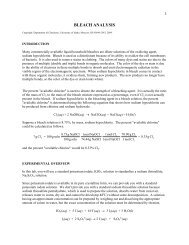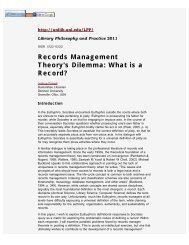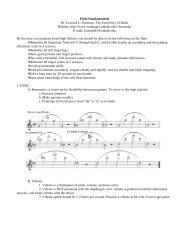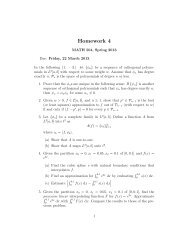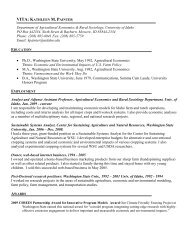Gandhi, Ahimsa, and the Self - University of Idaho
Gandhi, Ahimsa, and the Self - University of Idaho
Gandhi, Ahimsa, and the Self - University of Idaho
You also want an ePaper? Increase the reach of your titles
YUMPU automatically turns print PDFs into web optimized ePapers that Google loves.
GANDHI, AHIMSA, AND THE SELF 1<br />
(<strong>G<strong>and</strong>hi</strong> Marg 15:1 [April-June, 1993], pp. 24-36)<br />
Individuality is <strong>and</strong> is not even as each drop in <strong>the</strong> ocean is an individual <strong>and</strong> is not. It is<br />
not because apart from <strong>the</strong> ocean it has no existence. It is because <strong>the</strong> ocean has no<br />
existence if <strong>the</strong> drop has not, i.e., has no individuality. They are beautifully interdepen-<br />
dent. And if this is true <strong>of</strong> <strong>the</strong> physical law, how much more so <strong>of</strong> <strong>the</strong> spiritual world!<br />
--M. K. <strong>G<strong>and</strong>hi</strong>, Letter to P. G. Ma<strong>the</strong>w, September 8, 1930<br />
At least six book-length studies <strong>and</strong> one journal volume have been devoted to ahimsa, but<br />
none <strong>of</strong> <strong>the</strong>m have related <strong>the</strong> principle to <strong>the</strong> ontology <strong>of</strong> self. 2 In his <strong>Ahimsa</strong>: Non-Violence in<br />
Indian Tradition, <strong>the</strong> best book on <strong>the</strong> subject, Uno Tahtinen notes <strong>the</strong> differences among <strong>the</strong><br />
upanishadic, Jain, <strong>and</strong> Buddhist doctrines <strong>of</strong> self, but he concludes that <strong>the</strong>se differences are "irrelevant<br />
for <strong>the</strong> practice <strong>of</strong> non-violence." 3 It seems to me, however, that one's view <strong>of</strong> <strong>the</strong> self obviously affects<br />
one's social practices. If individual agency is unreal, as Advaita Vedanta maintains, <strong>the</strong>n it is difficult to<br />
see how a dynamic <strong>and</strong> engaged practice <strong>of</strong> ahimsa can be possible. On <strong>the</strong> o<strong>the</strong>r h<strong>and</strong>, if <strong>the</strong> self is<br />
real but exhorted to detach itself from o<strong>the</strong>r selves <strong>and</strong> from an unredeemable nature (<strong>the</strong> Jain <strong>and</strong><br />
Sankhya-Yoga view), <strong>the</strong>n it is uncertain how ei<strong>the</strong>r real engagement with o<strong>the</strong>rs or ecological values<br />
can be supported. In ano<strong>the</strong>r work I have argued <strong>the</strong>se points in some detail, <strong>and</strong> I have concluded<br />
that Buddhism, primarily because <strong>of</strong> its relational view <strong>of</strong> <strong>the</strong> self, is better able to present ahimsa as a<br />
positive virtue in <strong>the</strong> framework <strong>of</strong> a comprehensive social ethics.<br />
<strong>G<strong>and</strong>hi</strong> did not have a consistent doctrine <strong>of</strong> <strong>the</strong> self--his fervent individualism was always in<br />
tension with his Hindu pan<strong>the</strong>ism--<strong>and</strong> I believe that contemporary <strong>G<strong>and</strong>hi</strong>ans should take a middle
way between <strong>the</strong>se extremes. In Section I, I examine <strong>the</strong> influence <strong>of</strong> Jainism, Buddhism, Christianity,<br />
<strong>and</strong> Socrates on <strong>G<strong>and</strong>hi</strong>'s view <strong>of</strong> <strong>the</strong> self. Section II contains an argument that ahimsa should not<br />
have absolute value, as <strong>the</strong> Jains imply, but should be made, as <strong>G<strong>and</strong>hi</strong> intimated, an enabling virtue for<br />
higher values. Section III is a discussion <strong>of</strong> <strong>G<strong>and</strong>hi</strong>'s eccentric definition <strong>of</strong> Advaita Vedanta <strong>and</strong><br />
Ramashray Roy's misguided attempt to interpret <strong>G<strong>and</strong>hi</strong>'s view <strong>of</strong> <strong>the</strong> self in terms <strong>of</strong> this philosophy.<br />
Finally, in Section IV, I analyze <strong>G<strong>and</strong>hi</strong>'s "drop <strong>and</strong> <strong>the</strong> ocean" analogy, <strong>and</strong> I suggest that an organic<br />
analogy would better support his belief in a reformed caste system <strong>and</strong> his view that individual self-<br />
realization is prior to <strong>the</strong> salvation <strong>of</strong> <strong>the</strong> whole.<br />
Writing to a Burmese friend in 1919, <strong>G<strong>and</strong>hi</strong> said that "when in 1890 or 1891, I became<br />
acquainted with <strong>the</strong> teaching <strong>of</strong> <strong>the</strong> Buddha, my eyes were opened to <strong>the</strong> limitless possibilities <strong>of</strong> non-<br />
violence." 4 When he speaks <strong>of</strong> "<strong>G<strong>and</strong>hi</strong>'s pr<strong>of</strong>ound reinterpretation <strong>of</strong> Hindu values in <strong>the</strong> light <strong>of</strong> <strong>the</strong><br />
message <strong>of</strong> <strong>the</strong> Buddha," 5 Raghavan Iyer sees, more than any o<strong>the</strong>r <strong>G<strong>and</strong>hi</strong> scholar I have read, <strong>the</strong> full<br />
scope <strong>of</strong> <strong>the</strong> Buddha's influence on <strong>G<strong>and</strong>hi</strong>. My <strong>the</strong>sis is that <strong>G<strong>and</strong>hi</strong>'s principles <strong>of</strong> nonviolence can be<br />
best interpreted using Buddhist philosophy.<br />
I<br />
<strong>G<strong>and</strong>hi</strong>'s greatest contribution to <strong>the</strong> concept <strong>of</strong> nonviolence was to build a bridge, principally<br />
through action <strong>and</strong> only afterward by thought, between its application for <strong>the</strong> social good as well as<br />
individual spiritual development. This involved syn<strong>the</strong>sizing Vedic <strong>and</strong> ascetic views <strong>of</strong> nonviolence <strong>and</strong><br />
making ahimsa a powerful political tool. <strong>G<strong>and</strong>hi</strong> transformed ahimsa's earlier world-denying<br />
expressions into a world-affirming Realpolitik, one that drove an imperial power from India. <strong>G<strong>and</strong>hi</strong><br />
claimed that ahimsa is not "a resignation from all real fighting. . . . On <strong>the</strong> contrary, . . . nonviolence . . .
is more active <strong>and</strong> more real fighting against wickedness than retaliation whose very nature is to<br />
increase wickedness." 6 The culmination <strong>of</strong> <strong>G<strong>and</strong>hi</strong>'s philosophy was <strong>the</strong> principle <strong>of</strong> "soul force"<br />
(satyagraha), <strong>and</strong> his main contention was that soul force will always, in <strong>the</strong> end, win over brute force.<br />
The influence <strong>of</strong> Jainism on <strong>G<strong>and</strong>hi</strong> was not as great as he or o<strong>the</strong>rs have claimed. 7 His<br />
decision, on several occasions, to fast unto death, given its political motivations, is very different from<br />
<strong>the</strong> exclusively spiritual goal <strong>of</strong> <strong>the</strong> Jain fast-death. In a letter to <strong>G<strong>and</strong>hi</strong>, a Jain phrased <strong>the</strong> difference<br />
very aptly: "Whereas your view <strong>of</strong> ahimsa is based on <strong>the</strong> philosophy <strong>of</strong> action, that <strong>of</strong> <strong>the</strong> Jains is<br />
based on that <strong>of</strong> renunciation <strong>of</strong> action." 8 <strong>G<strong>and</strong>hi</strong> responded, following <strong>the</strong> karma yoga <strong>of</strong> <strong>the</strong><br />
Bhagavad-gita, by saying that he had melded renunciation <strong>and</strong> action into one force.<br />
One might attribute this difference to <strong>the</strong> resepctive concepts <strong>of</strong> <strong>the</strong> self: <strong>the</strong> isolation <strong>of</strong> <strong>the</strong> Jain self<br />
versus <strong>the</strong> relational <strong>and</strong> o<strong>the</strong>r-regarding elements <strong>of</strong> <strong>G<strong>and</strong>hi</strong>'s Buddhist-like compassion. Spiritual<br />
suicide would constitute <strong>the</strong> ultimate release <strong>of</strong> <strong>the</strong> Jain jiva from <strong>the</strong> corrupting influences <strong>of</strong> matter.<br />
On <strong>the</strong> o<strong>the</strong>r h<strong>and</strong>, a Buddhist, because <strong>of</strong> a nonsubstantial view <strong>of</strong> <strong>the</strong> self, would learn not to crave a<br />
pure self free from matter <strong>and</strong> would be more concerned about <strong>the</strong> karmic effects <strong>of</strong> suicide as <strong>the</strong><br />
ultimate violence to <strong>the</strong> self.<br />
With its flexibility <strong>and</strong> this-worldly emphasis, <strong>G<strong>and</strong>hi</strong>'s view <strong>of</strong> nonviolence is definitely more in<br />
line with Buddhism. Iyer states that "<strong>G<strong>and</strong>hi</strong> was, in fact, following in <strong>the</strong> footsteps <strong>of</strong> <strong>the</strong> Buddha in<br />
showing <strong>the</strong> connection between <strong>the</strong> service <strong>of</strong> suffering humanity <strong>and</strong> <strong>the</strong> process <strong>of</strong> self-purification." 9<br />
Albert Schweitzer concurs: "<strong>G<strong>and</strong>hi</strong> continues what <strong>the</strong> Buddha began. In <strong>the</strong> Buddha <strong>the</strong> spirit <strong>of</strong> love<br />
sets itself <strong>the</strong> task <strong>of</strong> creating different spiritual conditions in <strong>the</strong> world; in <strong>G<strong>and</strong>hi</strong> it undertakes to<br />
transform all worldly conditions." 10 <strong>G<strong>and</strong>hi</strong> said that <strong>the</strong> Buddha was <strong>the</strong> greatest teacher <strong>of</strong> ahimsa<br />
<strong>and</strong> that <strong>the</strong> "Buddha taught us to defy appearances <strong>and</strong> trust in <strong>the</strong> final triumph <strong>of</strong> Truth <strong>and</strong> Love." 11
Like <strong>the</strong> Buddhists, <strong>G<strong>and</strong>hi</strong> believed that ashimsa without compassion is nothing, just as gold is an<br />
amorphous material without goldsmith's artistic shape or <strong>the</strong> root is nothing without <strong>the</strong> magnificent<br />
tree. 12 This means that for both <strong>G<strong>and</strong>hi</strong> <strong>and</strong> Buddhism ahimsa is an enabling virtue in <strong>the</strong> context <strong>of</strong> a<br />
comprehensive social ethics.<br />
<strong>G<strong>and</strong>hi</strong> actually allowed many exceptions to ahimsa, based on very realistic <strong>and</strong> pragmatic<br />
considerations, exceptions that sc<strong>and</strong>alized many Hindus <strong>and</strong> Jains. His view is summed up in <strong>the</strong><br />
surprising qualification that "all killing is not himsa," 13 <strong>and</strong> his equally provocative imperative that it is<br />
better to fight an aggressor than to be a coward. In contrast to <strong>the</strong> Jain position, <strong>G<strong>and</strong>hi</strong>'s ahimsa is<br />
reactive <strong>and</strong> flexible not passive <strong>and</strong> absolute. Throughout October 1928, <strong>G<strong>and</strong>hi</strong> carried on a lively<br />
debate with various respondents in Young India. <strong>G<strong>and</strong>hi</strong> defended his decision to euthanize an<br />
incurable calf, <strong>and</strong> even went on to list <strong>the</strong> conditions for human euthanasia that do not violate ahimsa.<br />
He also thought that tigers, snakes, <strong>and</strong> rabid dogs might have to be killed if <strong>the</strong>y threaten human life.<br />
The vow <strong>of</strong> ahimsa is indeed absolute, but <strong>the</strong> exigencies <strong>of</strong> human finitude force us, tragically, to<br />
violate this vow every day. Unlike <strong>the</strong> casuistry <strong>of</strong> <strong>the</strong> Vedic tradition, which somehow transformed <strong>the</strong><br />
himsa <strong>of</strong> animal sacrifice or military conquest into <strong>the</strong> highest forms <strong>of</strong> ahimsa, <strong>G<strong>and</strong>hi</strong> insisted that we<br />
must accept all <strong>the</strong> injury we do as culpable.<br />
In a response to queries about apparent inconsistencies--e.g., holding to advaita <strong>and</strong> dvaita at<br />
<strong>the</strong> same time--<strong>G<strong>and</strong>hi</strong> answered that he believed in Jain view <strong>of</strong> <strong>the</strong> many-sidedness (anekantavada)<br />
<strong>of</strong> reality, <strong>and</strong> that his "anekantavada is <strong>the</strong> result <strong>of</strong> <strong>the</strong> twin doctrine <strong>of</strong> satya <strong>and</strong> ahimsa." 14 If one<br />
thinks <strong>of</strong> <strong>G<strong>and</strong>hi</strong>'s view <strong>of</strong> relative truth <strong>and</strong> how this would preclude one thinking ill <strong>of</strong> o<strong>the</strong>rs with<br />
differing beliefs, <strong>the</strong>n <strong>the</strong> alliance with Jain anekantavada is a natural one. In <strong>the</strong> same passage <strong>G<strong>and</strong>hi</strong><br />
continues: "Formerly I used to resent <strong>the</strong> ignorance <strong>of</strong> my opponents. Today I can love <strong>the</strong>m because I
am gifted with <strong>the</strong> eye to see myself as o<strong>the</strong>rs see me <strong>and</strong> vice versa."<br />
Although <strong>the</strong> practical effects <strong>of</strong> such a view are obvious <strong>and</strong> salutary, it is, I believe,<br />
philosophically unsatisfactory. Ironicly, anekantavada does not seem to have prevented Jains from<br />
holding a ra<strong>the</strong>r one-sided dualism, from imputing perfect knowledge to <strong>the</strong>ir Tirthankaras, <strong>and</strong> giving<br />
absolute value to ahimsa. Ra<strong>the</strong>r than an extremely loose "I am everything" position, I suggest that an<br />
early Buddhist agnosticism, using what I call a "nei<strong>the</strong>r/nor" dialectic, would have better served <strong>G<strong>and</strong>hi</strong>'s<br />
purposes. 15 Buddhist agnosticism led to a "contextual pragmatism," a phrase David Kalupahana uses to<br />
describe early Buddhist ethics, 16 but it would also be an appropriate label for <strong>G<strong>and</strong>hi</strong>an ethics as well.<br />
<strong>G<strong>and</strong>hi</strong>'s view <strong>of</strong> <strong>the</strong> self is an interesting amalgam <strong>of</strong> <strong>the</strong> Socratic daimon, <strong>the</strong> Jain jiva, <strong>and</strong><br />
<strong>the</strong> upanishadic atman. Unlike <strong>the</strong> Jains, <strong>the</strong> Vedantic <strong>G<strong>and</strong>hi</strong> viewed <strong>the</strong> ideal self as inextricably<br />
bound up in its relations with o<strong>the</strong>rs <strong>and</strong> society. But Jain individualism, most likely learned from<br />
Raich<strong>and</strong>, may have persuaded <strong>G<strong>and</strong>hi</strong> to revise Vedanta in a significant way. (<strong>G<strong>and</strong>hi</strong> claimed that<br />
Raich<strong>and</strong>, a diamond merchant <strong>and</strong> early intellectual friend, was just as much an influence on him as<br />
Tolstoy <strong>and</strong> Ruskin.) Although nominally a Jain, <strong>and</strong> taken by some even to be <strong>the</strong> 25th Tirthankara<br />
(even Raich<strong>and</strong> indulged <strong>the</strong> thought), Raich<strong>and</strong>'s view <strong>of</strong> <strong>the</strong> soul is much like <strong>G<strong>and</strong>hi</strong>'s: a mix <strong>of</strong><br />
Jainism, Vedanta, <strong>and</strong> Vaishnavism. The Raich<strong>and</strong> connection alerts us not to think <strong>of</strong> Advaita<br />
Vedanta every time <strong>G<strong>and</strong>hi</strong> uses <strong>the</strong> word atman. When <strong>G<strong>and</strong>hi</strong> says that "atman can be liberated<br />
only by itself," D. K. Bedekar is convinced that, because <strong>of</strong> Raich<strong>and</strong>'s view that atman is <strong>the</strong> in-<br />
dividual Jain jiva, this statement could be read as: "true autonomy <strong>of</strong> <strong>the</strong> human spirit can only be<br />
attained by <strong>the</strong> human mind which breaks through snares <strong>and</strong> repressions." 17 Consistent with <strong>the</strong> <strong>the</strong>sis<br />
<strong>of</strong> this essay, <strong>G<strong>and</strong>hi</strong> <strong>and</strong> Raich<strong>and</strong> parted ways on <strong>the</strong> question <strong>of</strong> social involvement, with Raich<strong>and</strong><br />
advocating <strong>and</strong> living strict disengagement from <strong>the</strong> world. The influence <strong>of</strong> Raichm<strong>and</strong> can help us
appreciate, but not condone, <strong>G<strong>and</strong>hi</strong>'s relative ease in affirming both individualism <strong>and</strong> pan<strong>the</strong>ism at <strong>the</strong><br />
same time.<br />
Regarding <strong>the</strong> self, one might think that Christianity must have influenced <strong>G<strong>and</strong>hi</strong>'s views.<br />
Except for using <strong>the</strong> phrases "special creation <strong>of</strong> God" <strong>and</strong> "image <strong>of</strong> God," 18 this does not seem to<br />
have been <strong>the</strong> case. Iyer contends that <strong>the</strong> principal western influence on <strong>G<strong>and</strong>hi</strong> was Socrates, from<br />
whom he derived a view <strong>of</strong> an inviolable <strong>and</strong> fiercely independent conscience. (<strong>G<strong>and</strong>hi</strong> translated<br />
Plato's Apology into Gujarati.) In an impressive two-page analysis, Iyer demonstrates that <strong>the</strong>re is no<br />
Indian equivalent to Socrates' daimon, 19 an "inner voice" that claims, as <strong>G<strong>and</strong>hi</strong> said <strong>of</strong>ten during his<br />
campaigns, an authority higher than <strong>the</strong> laws <strong>of</strong> <strong>the</strong> l<strong>and</strong>.<br />
Iyer may be correct on this point, but it is not very clear if <strong>G<strong>and</strong>hi</strong>'s conscience is consistently<br />
Socratic. One passage on <strong>G<strong>and</strong>hi</strong>'s "Inner Voice" contains an odd mix <strong>of</strong> popular Christianity <strong>and</strong><br />
situation ethics: "The 'Inner Voice' may mean a message from God or from <strong>the</strong> Devil, for both are<br />
wrestling in <strong>the</strong> human breast. Acts determine <strong>the</strong> nature <strong>of</strong> <strong>the</strong> voice." 20 Ano<strong>the</strong>r passage gives<br />
<strong>G<strong>and</strong>hi</strong>an conscience an infallible divine sanction, independent <strong>of</strong> reason or result: "For me <strong>the</strong> Voice <strong>of</strong><br />
God, <strong>of</strong> Conscience, <strong>of</strong> Truth or <strong>the</strong> Inner Voice . . . mean one <strong>and</strong> <strong>the</strong> same thing . . . . For me <strong>the</strong><br />
Voice was more real than my own existence. It has never failed me, <strong>and</strong> for that matter, any one<br />
else." 21<br />
Bedekar contends that, when searching for a word for conscience, <strong>G<strong>and</strong>hi</strong> deliberately avoided<br />
<strong>the</strong> word atman <strong>and</strong> instead chose antaratman. Bedekar <strong>of</strong>fers his own translation from <strong>G<strong>and</strong>hi</strong>'s<br />
autobiography: ". . . But so long as I have not directly experienced this truth, till <strong>the</strong>n that which my inner<br />
self (antaratman) counts as true, that which is only conceived by me as true, will be counted by me as<br />
my support, my beacon, as <strong>the</strong> foundation for <strong>the</strong> course <strong>of</strong> my life." 22 This passage, besides confirming
conscience as <strong>the</strong> highest authority, also reveals a corollary maxim: as absolute truth is not available to<br />
humans, we must act on <strong>the</strong> finite truth we find in ourselves. It also supports <strong>the</strong> first view <strong>of</strong> pragmatic<br />
conscience above <strong>and</strong> <strong>the</strong> contextual pragramtism discussed previously.<br />
<strong>G<strong>and</strong>hi</strong>'s commitment to individual autonomy was so strong that he unfortunately resisted <strong>the</strong><br />
relational <strong>and</strong> social self he found in Hegel <strong>and</strong> Marx, a position that has now been confirmed <strong>and</strong><br />
reformulated by 20th Century thinkers as diverse as George Herbert Mead, Martin Heidegger,<br />
Maurice Merleau-Ponty, <strong>and</strong> Martin Buber. It is truly ironic that <strong>the</strong> loss <strong>of</strong> individual freedom that<br />
<strong>G<strong>and</strong>hi</strong> feared in Hegel is immeasurably greater in <strong>the</strong> Advaita Vedanta that he unwisely affirmed. We<br />
shall return to this issue in Section III.<br />
II<br />
The ancient view <strong>of</strong> a sympa<strong>the</strong>tic continuum in which all things are internally related is one that<br />
<strong>the</strong> new ecological consciousness has rediscovered <strong>and</strong> affirmed. It also provided <strong>the</strong> basis for <strong>the</strong> Jain<br />
view <strong>of</strong> <strong>the</strong> equality <strong>of</strong> all souls. In <strong>the</strong> Jain Uttaradhyayana Sutra ahimsa is defined as being "equal-<br />
minded to all creatures <strong>and</strong> regard <strong>the</strong>m as one's own self. . . ." 23 Compared to Hinduism <strong>and</strong><br />
Buddhism, where <strong>the</strong>re is a hierarchy <strong>of</strong> consideration (viz., higher "minded" creatures have priority<br />
over <strong>the</strong> lower), 24 Jainism attempts to enforce a strict egalitarianism regarding <strong>the</strong> objects <strong>of</strong> injurious<br />
action. Simply put, every life unit (jiva) has equal value. Therefore, Jain ahimsa is based on <strong>the</strong><br />
equality <strong>and</strong> universal kinship <strong>of</strong> all souls.<br />
This egalitarianism is a great Jain achievement, but its formulation is questionable. First, every<br />
Jain jiva, just as every Sankhya purusha, is distinct <strong>and</strong> separate from every o<strong>the</strong>r, so a Jain cannot,<br />
strictly speaking, regard ano<strong>the</strong>r self as her "own self." Second, sympathy <strong>and</strong> reciprocity, along with
equality, must be necessary conditions for ahimsa. I believe that true sympathy <strong>and</strong> reciprocity are<br />
possible only in a system <strong>of</strong> internal relations. Jain atomism, in so far as it pertains to personal salvation,<br />
is based on external relations, i.e., <strong>the</strong> possibility <strong>of</strong> <strong>the</strong> soul to become completely independent from<br />
everything else in <strong>the</strong> cosmos. A Jain may, <strong>the</strong>oretically, be able to recognize ano<strong>the</strong>r soul as equal; but<br />
it is difficult to see, given <strong>the</strong> Jains' insistence on absolute independence <strong>of</strong> <strong>the</strong> liberated soul, 25 how<br />
souls can be truly sympa<strong>the</strong>tic ("feeling with" is <strong>the</strong> literal meaning) with one ano<strong>the</strong>r. In Buddhism, on<br />
<strong>the</strong> o<strong>the</strong>r h<strong>and</strong>, we find that relatedness <strong>and</strong> interdependence are <strong>the</strong> very essence <strong>of</strong> reality, so that<br />
<strong>the</strong>re is a near perfect match between ontology <strong>and</strong> ethics.<br />
It is important to note that <strong>the</strong> virtue <strong>of</strong> compassion requires sympathy as an enabling virtue. It<br />
is significant that N. D. Bhargava, a Jain philosopher, defends <strong>the</strong> negative formulation <strong>of</strong> ahimsa,<br />
because "if we speak <strong>of</strong> love, we can think <strong>of</strong> one form or <strong>the</strong> o<strong>the</strong>r <strong>of</strong> attachment. . . ." 26 (To<br />
be fair, Bhargava does insist that <strong>the</strong> use <strong>of</strong> <strong>the</strong> negative formulation does not mean that <strong>the</strong> Jain should<br />
not love.) Bhargava is certainly correct about <strong>the</strong> dangers <strong>of</strong> self-centered love, but his extreme caution<br />
on this point again reveals <strong>the</strong> radical nature <strong>of</strong> <strong>the</strong> Jain approach. By removing <strong>the</strong> self from its social<br />
<strong>and</strong> ecological relations, one can obviously remove most <strong>of</strong> <strong>the</strong> dangers <strong>of</strong> attachment <strong>and</strong> <strong>the</strong> injury<br />
that necessarily follows. But one also risks ano<strong>the</strong>r danger: alienating people from one ano<strong>the</strong>r <strong>and</strong><br />
removing <strong>the</strong> content <strong>and</strong> meaning <strong>of</strong> a whole range <strong>of</strong> virtues that are arguably more important than<br />
ahimsa itself. Both <strong>G<strong>and</strong>hi</strong> <strong>and</strong> <strong>the</strong> Buddha believed that without compassion ahimsa was not worth<br />
anything at all.<br />
When Bhargava states that ahimsa is "<strong>the</strong> intrinsic nature <strong>of</strong> man," he seems to imply that<br />
ahimsa has absolute value. <strong>G<strong>and</strong>hi</strong> appears to agree with Bhargava when he writes, in <strong>the</strong> words <strong>of</strong><br />
Vedantic absolutism, that "ahimsa is <strong>the</strong> very nature <strong>of</strong> <strong>the</strong> atman." 27 More frequently, however, he
implies that ahimsa is a virtue that must be attained, <strong>and</strong> he claims that it is a means to a higher end,<br />
usually Truth or God. 28 In his interpretation <strong>of</strong> <strong>the</strong> Gita, <strong>G<strong>and</strong>hi</strong> connects ahimsa with selfless action<br />
(anasakti), <strong>and</strong> ahimsa is "a necessary preliminary. . . included in. . . does not go beyond"<br />
anasakti. 29 Resisting <strong>the</strong> natural temptation to absolutize it, <strong>G<strong>and</strong>hi</strong> has ascertained <strong>the</strong> proper place <strong>of</strong><br />
ahimsa among <strong>the</strong> virtues. <strong>Ahimsa</strong> begins in self-restraint, self-purification, <strong>and</strong> selflessness <strong>and</strong> ends<br />
in love <strong>and</strong> compassion.<br />
Making ahimsa a disposition ra<strong>the</strong>r than <strong>the</strong> essence <strong>of</strong> <strong>the</strong> soul preserves <strong>the</strong> essential element<br />
<strong>of</strong> freedom. <strong>G<strong>and</strong>hi</strong> frequently spoke <strong>of</strong> <strong>the</strong> animal side <strong>of</strong> human nature, <strong>and</strong> how one must struggle to<br />
choose violence over nonviolence. If we are nonviolent by nature, <strong>the</strong>n we cannot be praised for<br />
choosing peaceful actions. On <strong>the</strong> o<strong>the</strong>r h<strong>and</strong>, we cannot be completely devoid <strong>of</strong> a disposition for<br />
noninjury, for, as <strong>G<strong>and</strong>hi</strong> says, "means to be means must always be within our reach." 30 (One is<br />
reminded <strong>of</strong> Mencius' view that <strong>the</strong> virtues exist as potentials within <strong>the</strong> soul; <strong>and</strong>, like seeds, <strong>the</strong>y must<br />
be nurtured for <strong>the</strong> good life to flower.) Fur<strong>the</strong>rmore, <strong>G<strong>and</strong>hi</strong> frequently reminds us that true ahimsa<br />
towards an attacker must combine physical nonretaliation with love <strong>and</strong> compassion. (In o<strong>the</strong>r words,<br />
mere passivity without <strong>the</strong> proper disposition is not necessarily ahimsa.) Therefore, ahimsa must be a<br />
means to <strong>the</strong> end <strong>of</strong> <strong>the</strong> spiritual life, not an end in itself. The true proponent <strong>of</strong> nonviolence would hold<br />
that only life (<strong>G<strong>and</strong>hi</strong> prefers Truth or God) has intrinsic value, <strong>and</strong> ahimsa obviously is <strong>the</strong> penultimate<br />
means <strong>of</strong> preserving life.<br />
III<br />
In his book <strong>Self</strong> <strong>and</strong> Society: A Study in <strong>G<strong>and</strong>hi</strong>an Thought, Ramashray Roy uses <strong>the</strong><br />
Catholic philosopher Jacques Maritain to elucidate <strong>G<strong>and</strong>hi</strong>'s concept <strong>of</strong> self. Roy's exposition is clear
<strong>and</strong> insightful <strong>and</strong> he introduces <strong>the</strong> concept <strong>of</strong> <strong>the</strong> relational self very effectively. Here is a sample <strong>of</strong><br />
Roy's summary <strong>of</strong> Maritain's view:<br />
considers freedom as self-activity, autonomy <strong>and</strong> transcendence <strong>of</strong><br />
objective determination in which <strong>the</strong> conception <strong>of</strong> community happens to be an integral<br />
part <strong>of</strong> <strong>the</strong> human psyche <strong>and</strong> <strong>the</strong>refore individuality <strong>and</strong> sociality become mutually<br />
supportive. 31<br />
Roy also interprets <strong>G<strong>and</strong>hi</strong> as an Advaitin, so it cannot be correct for him to say that "<strong>G<strong>and</strong>hi</strong>'s<br />
conception <strong>of</strong> <strong>the</strong> self is no different from Maritain's concept <strong>of</strong> person." 32 <strong>G<strong>and</strong>hi</strong>'s position should<br />
have been more like Maritain's, but <strong>the</strong> texts reveal a radical individualism at odds with Maritain or a<br />
pan<strong>the</strong>ism that swallows up <strong>the</strong> individual.<br />
The Vedantic <strong>G<strong>and</strong>hi</strong> is a pan<strong>the</strong>ist concerning <strong>the</strong> relationship <strong>of</strong> God <strong>and</strong> <strong>the</strong> world. The<br />
Advaitin, as John White has reminded us, 33 is not a pan<strong>the</strong>ist, but a transcendental monist. For a<br />
pan<strong>the</strong>ist God <strong>and</strong> <strong>the</strong> world are identical, but an Advaitin believes that Brahman completely transcends<br />
a fully derivative <strong>and</strong> separate world. Like a good pan<strong>the</strong>ist, <strong>G<strong>and</strong>hi</strong> constantly identifies God, <strong>the</strong><br />
world, <strong>and</strong> life, <strong>and</strong> he rarely says that <strong>the</strong> world is unreal. He instinctively realized how incompatible<br />
such a view would be for his activist philosophy <strong>of</strong> nonviolence. If <strong>the</strong> world <strong>of</strong> constant change <strong>and</strong><br />
social engagement is ultimately an illusion, <strong>G<strong>and</strong>hi</strong>'s dynamic ahimsa cannot find support in Advaita<br />
Vedanta.<br />
An effective way <strong>of</strong> conceiving absolute monism is <strong>the</strong> prism analogy. If Brahman is white light,<br />
<strong>and</strong> <strong>the</strong> color spectrum is <strong>the</strong> phenomenal world, <strong>the</strong>n <strong>the</strong> prism that refracts <strong>the</strong> light st<strong>and</strong>s for<br />
ignorance. If one eliminates ignorance, <strong>the</strong>n one can see that everything is just an undifferentiated one.<br />
Due to ignorance, <strong>the</strong> world <strong>and</strong> its qualitative differences have a derivative reality only. Realizing <strong>the</strong>
identity <strong>of</strong> Atman <strong>and</strong> Brahman is like waking up from a dream <strong>and</strong> discovering that those images were<br />
only fleeting agitations <strong>of</strong> <strong>the</strong> mind.<br />
In <strong>the</strong> article cited above, John White has <strong>of</strong>fered a criticism <strong>of</strong> Advaita Vedanta that goes very<br />
nicely with <strong>the</strong> prism analogy. If Shankara assumes that some people are enlightened, while many<br />
o<strong>the</strong>rs remain in ignorance (which he must obviously hold), <strong>the</strong>n clearly Shankara's transcendental<br />
monism is untenable. The world will continue to exist for <strong>the</strong> unenlightened, but somehow it has ceased<br />
to exist for <strong>the</strong> liberated ones. (As White points out, <strong>the</strong> only way that <strong>the</strong> Advaitin can answer his<br />
argument is to deny <strong>the</strong> validity <strong>of</strong> <strong>the</strong> law <strong>of</strong> contradiction.) The result is that Shankara's alleged<br />
nondualism is, at least until <strong>the</strong> liberation <strong>of</strong> all souls, a transcendental dualism, roughly similar to<br />
Christian orthodoxy. Fur<strong>the</strong>rmore, it means that, if some selves are liberated <strong>and</strong> some are not, <strong>the</strong>re<br />
must also a real plurality <strong>of</strong> souls--i.e., many different soul-prisms refracting <strong>the</strong>ir own perspectives <strong>of</strong><br />
<strong>the</strong> world.<br />
<strong>G<strong>and</strong>hi</strong> declares allegiance to Advaita Vedanta, but he only interprets it to mean <strong>the</strong> unity <strong>of</strong><br />
God <strong>and</strong> humans:<br />
I believe in <strong>the</strong> rock-bottom doctrine <strong>of</strong> Advaita <strong>and</strong> my interpretation <strong>of</strong> Advaita<br />
excludes totally any idea <strong>of</strong> superiority at any state whatsoever. I believe implicitly that<br />
all men are born equal. All . . . have <strong>the</strong> same soul as any o<strong>the</strong>r. 34<br />
<strong>G<strong>and</strong>hi</strong>, like Shankara, also extends this unity to "all that lives." 35 Everything in <strong>the</strong> universe contains<br />
atman, <strong>and</strong> "ahimsa is <strong>the</strong> very nature <strong>of</strong> atman," so <strong>G<strong>and</strong>hi</strong>an nonviolence is not only ecological, but<br />
also cosmic in scope. <strong>G<strong>and</strong>hi</strong>'s pan<strong>the</strong>ism, however, resacralizes <strong>the</strong> world, while Sankara's<br />
transcendental monism desacralizes it.<br />
Roy states that <strong>G<strong>and</strong>hi</strong>'s commitment to Advaita Vedanta allows him to have "a sense <strong>of</strong>
elatedness with o<strong>the</strong>r determinate beings. . . which, in turn, manifests itself in compassion, <strong>the</strong> ability to<br />
be affected by <strong>the</strong> suffering <strong>of</strong> o<strong>the</strong>rs." 36 The problem with this statement is that Shankara believed that<br />
relations <strong>and</strong> determinations are ultimately unreal, which means that suffering is also illusory. Most<br />
forms <strong>of</strong> pan<strong>the</strong>ism, especially <strong>the</strong> personalistic panen<strong>the</strong>ism <strong>of</strong> Ramanuja <strong>and</strong> process philosophy, do<br />
affirm real differences within a unitary cosmos. Given <strong>G<strong>and</strong>hi</strong>'s love for <strong>the</strong> Bhagavad-gita, <strong>and</strong> <strong>the</strong><br />
fact it does support <strong>the</strong> plurality <strong>of</strong> souls <strong>and</strong> embodies a strong personal <strong>the</strong>ism, he should have pre-<br />
ferred this view over Advaita Vedanta. (After all he did come from a Vaishnava family.)<br />
The concept <strong>of</strong> a permanent self underlying <strong>the</strong> phenomenal self is one idea that <strong>G<strong>and</strong>hi</strong> does<br />
sometimes appropriate from <strong>the</strong> upanishadic tradition. Roy supports this view <strong>of</strong> self in his retelling,<br />
from <strong>the</strong> Panchatantra, <strong>the</strong> parable <strong>of</strong> <strong>the</strong> tiger cub. 37 One day a tiger, while planning an attack on a<br />
herd <strong>of</strong> goats, saw a tiger cub among <strong>the</strong>m. The tiger took <strong>the</strong> cub to a pond so that he could see in his<br />
own reflection that he was not a goat. After some adjustment <strong>the</strong> tiger cub eventually realized his true<br />
predatory nature. Even though brought into <strong>the</strong> greatest dramatic relief by this story, Roy does not<br />
seem to realize <strong>the</strong> negative implications <strong>of</strong> <strong>the</strong> permanent self for <strong>the</strong> practice <strong>of</strong> ahimsa. He should<br />
have used recent experiments that have shown that "aggressive" monkeys, raised from birth with<br />
"pacifist" monkeys, learn <strong>the</strong> nonviolent behavior <strong>of</strong> <strong>the</strong>ir adopted parents <strong>and</strong> siblings. 38<br />
After explaining this story in terms <strong>of</strong> <strong>the</strong> unchanging atman, Roy inexplicably turns to <strong>G<strong>and</strong>hi</strong>'s<br />
view that, although we have an animal nature, we can tap our spiritual natures <strong>and</strong> learn to become<br />
nonviolent. Interestingly enough, <strong>G<strong>and</strong>hi</strong> uses <strong>the</strong> same story (substituting a lion for <strong>the</strong> tiger <strong>and</strong> sheep<br />
for goats), but he clearly distinguishes animals from humans, created in <strong>the</strong> image <strong>of</strong> God, who are free<br />
<strong>and</strong> obligated to change <strong>the</strong>ir animal natures. 39 <strong>G<strong>and</strong>hi</strong> explicitly connects "<strong>the</strong> capacity <strong>of</strong> nonviolence"<br />
with a rejection <strong>of</strong> "<strong>the</strong> <strong>the</strong>ory <strong>of</strong> <strong>the</strong> permanent inelasticity <strong>of</strong> human nature." 40 This means that <strong>G<strong>and</strong>hi</strong>
should have rejected <strong>the</strong> Atman <strong>of</strong> <strong>the</strong> Upanishads, <strong>and</strong> all o<strong>the</strong>r Indian views <strong>of</strong> <strong>the</strong> self, because none<br />
<strong>of</strong> <strong>the</strong>m, except <strong>the</strong> Buddhist, <strong>of</strong>fers ei<strong>the</strong>r <strong>the</strong> agency or "elasticity" that <strong>G<strong>and</strong>hi</strong> required. Ironicly, <strong>the</strong><br />
tiger cub story is not compatible with any <strong>of</strong> <strong>the</strong> Indian selves, because <strong>the</strong> spiritually pure <strong>and</strong> empty<br />
atman, jiva, <strong>and</strong> purusha are, strictly speaking, nei<strong>the</strong>r predatory nor not predatory.<br />
One <strong>of</strong> <strong>the</strong> most momentous discoveries in modern social thought-- beginning with Marx,<br />
culminating in Sartre, <strong>and</strong> confirmed in studies <strong>of</strong> feral children--is that human beings have no "nature."<br />
(This is "no nature" in <strong>the</strong> sense <strong>of</strong> nonsubstantiality <strong>and</strong> potentiality, not "no nature" in <strong>the</strong> sense <strong>of</strong> a<br />
fully actualized, but empty spiritual substance.) In <strong>the</strong>ir concepts <strong>of</strong> no-self (anatman) <strong>and</strong> no-<br />
substance (anitya), <strong>the</strong> Buddhists anticipated this revolutionary insight. Studies <strong>of</strong> feral children have<br />
shown that <strong>the</strong> so-called human "essence" is so malleable <strong>and</strong> so vulnerable that children raised without<br />
<strong>the</strong> benefit <strong>of</strong> parents <strong>and</strong> normal socialization are reduced to a state, sadly enough, lower than most<br />
animals. All things being equal, weaned puppies <strong>and</strong> kittens grow up to be well functioning cats <strong>and</strong><br />
dogs, but a weaned child left completely to its own devices descends into an abyss <strong>of</strong> sensory<br />
deprivation <strong>and</strong> debilitating dysfunction.<br />
IV<br />
<strong>G<strong>and</strong>hi</strong> elucidated his pan<strong>the</strong>ism with a beautifully expressed "drop <strong>and</strong> <strong>the</strong> ocean" analogy that<br />
introduces this essay. Let us look at a similar passage before assessing <strong>the</strong> merits <strong>of</strong> this analogy for <strong>the</strong><br />
self-world problem.<br />
The ocean is composed <strong>of</strong> drops <strong>of</strong> water; each drop is an entity <strong>and</strong> yet it is a part <strong>of</strong><br />
<strong>the</strong> whole; '<strong>the</strong> one <strong>and</strong> <strong>the</strong> many.' In this ocean <strong>of</strong> life, we are little drops. My doctrine<br />
means that I must identify myself with life. . . . that I must share <strong>the</strong> majesty <strong>of</strong> life in <strong>the</strong>
presence <strong>of</strong> God. The sum-total <strong>of</strong> this life is God. 41<br />
This last sentence identifying God <strong>and</strong> life, something that Shankara never did, is <strong>the</strong> most succinct<br />
statement <strong>of</strong> <strong>G<strong>and</strong>hi</strong>an pan<strong>the</strong>ism. <strong>G<strong>and</strong>hi</strong> is certainly not <strong>the</strong> first to use water analogies to explain<br />
pan<strong>the</strong>ism, so <strong>the</strong> criticism that follows is not solely directed at him.<br />
The positive element <strong>of</strong> <strong>G<strong>and</strong>hi</strong>'s analogy is that he attempts to uphold individuation. <strong>G<strong>and</strong>hi</strong><br />
instinctively knew that political activism without individual agency is simply not possible. It is also true<br />
that any body <strong>of</strong> water is made <strong>of</strong> individual, but interdependent, molecules <strong>of</strong> water that <strong>of</strong>fer a rough<br />
analogue <strong>of</strong> a community <strong>of</strong> persons. The problem is that individual water molecules are not<br />
perceptible, so <strong>the</strong> individual is dissolved in <strong>the</strong> whole. Except for rain storms <strong>and</strong> turbulent seas,<br />
separate individuation <strong>of</strong> <strong>the</strong> sort that persons experience in society is not found in water drops. Finally,<br />
if <strong>the</strong> analogue <strong>of</strong> <strong>the</strong> ideal state is a perfectly calm sea, <strong>the</strong>re would be no significant differentiation at<br />
all. This analogy ultimately fails, for it does not present enough differentiation or qualitative difference.<br />
<strong>G<strong>and</strong>hi</strong> is certainly correct to say that "<strong>the</strong> drop also has <strong>the</strong> essence <strong>of</strong> <strong>the</strong> ocean, so it is no small<br />
thing," 42 but <strong>the</strong> content <strong>of</strong> <strong>the</strong> water is a "small thing" compared to <strong>the</strong> rich diversity <strong>of</strong> life both in <strong>and</strong><br />
out <strong>of</strong> <strong>the</strong> ocean itself.<br />
Spinning thread from a mass <strong>of</strong> cotton is yet ano<strong>the</strong>r analogy <strong>of</strong> <strong>the</strong> self-world relation to which<br />
<strong>G<strong>and</strong>hi</strong> alluded <strong>and</strong> actually practiced everyday. He was fond <strong>of</strong> quoting a saying from Akha, a<br />
medieval Gujarati saint: "Even as <strong>the</strong> thread spins out so be your life. Do what you may <strong>and</strong> receive <strong>the</strong><br />
grace <strong>of</strong> Hari." This analogy is better than <strong>the</strong> water drop image. The individual thread is clearly<br />
separate from its origin, <strong>and</strong> its connection to that origin (for Akha it is Vishnu) is equally clear. (We<br />
may think <strong>of</strong> <strong>the</strong> individual threads taking on various colors to symbolize qualitative differences.)<br />
Bedekar sums up <strong>the</strong> implications <strong>of</strong> this metaphor: ". . . <strong>the</strong> image evokes in <strong>G<strong>and</strong>hi</strong>'s modern mind a
life-project <strong>of</strong> unrepressed <strong>and</strong> continuous activity leading one to an awareness <strong>of</strong> one's own being." 43<br />
Again <strong>the</strong> analogy has its problems: thread is woven into cloth, <strong>and</strong> it, just like <strong>the</strong> water drop, is lost in<br />
<strong>the</strong> whole.<br />
<strong>G<strong>and</strong>hi</strong>'s statement that "corporate growth is <strong>the</strong>refore entirely dependent upon individual<br />
growth" 44 implies two concessions: (1) that his adoption <strong>of</strong> Advaita Vedanta was ill-advised; <strong>and</strong> that<br />
(2) <strong>the</strong> drop <strong>and</strong> thread analogies do not support such a crucial role for <strong>the</strong> individual. This passage<br />
suggests ano<strong>the</strong>r analogy for <strong>the</strong> self-society relation, viz., that <strong>of</strong> a living organism. Individuals are like<br />
bodily organs, each with <strong>the</strong>ir own identity <strong>and</strong> function <strong>and</strong> each contributing to <strong>the</strong> life <strong>of</strong> <strong>the</strong> whole.<br />
This model also keeps <strong>the</strong> Socratic <strong>G<strong>and</strong>hi</strong> from falling into <strong>the</strong> fallacy <strong>of</strong> social atomism--person-<br />
organs separating <strong>the</strong>mselves, by radical acts <strong>of</strong> conscience <strong>and</strong> protest, from <strong>the</strong> body politic.<br />
The principal objection to this analogy is that it is hierarchical <strong>and</strong> authoritarian--giving, for<br />
example, more value <strong>and</strong> authority to <strong>the</strong> brain than to <strong>the</strong> lowly gall bladder or feet, <strong>the</strong> loss <strong>of</strong> which a<br />
person can survive. <strong>G<strong>and</strong>hi</strong>, comparing organs <strong>of</strong> <strong>the</strong> body to <strong>the</strong> four castes, disagrees: "Is <strong>the</strong> head<br />
superior to <strong>the</strong> arms, <strong>the</strong> belly <strong>and</strong> <strong>the</strong> feet, or <strong>the</strong> feet superior to <strong>the</strong> o<strong>the</strong>r three? What will happen to<br />
<strong>the</strong> body if <strong>the</strong>se members quarrel about rank?" 45 One might well answer "Yes" to <strong>the</strong> first question<br />
<strong>and</strong> strongly advise <strong>the</strong> lower parts to obey <strong>the</strong> brain. If <strong>the</strong> brain did not outrank <strong>the</strong> rest <strong>of</strong> <strong>the</strong> organs,<br />
occasionally suppressing <strong>the</strong> actions <strong>of</strong> errant members, <strong>the</strong>n <strong>G<strong>and</strong>hi</strong>'s ahimsa would never be<br />
possible. Eschewing <strong>the</strong> hierarchy <strong>of</strong> <strong>the</strong> body, <strong>G<strong>and</strong>hi</strong>'s ideal <strong>of</strong> an egalitarian body politic is <strong>the</strong><br />
ashram, where, as I personally witnessed in Pondicherry, people, for no salary, were happily doing<br />
everything from washing dishes to speculating on Aurobindo's philosophy. Perhaps this is <strong>the</strong> way in<br />
which we ought to look at <strong>G<strong>and</strong>hi</strong>'s controversial support for a reformed caste system. "Caste" he<br />
explains, "does not connote superiority or inferiority. It simply recognizes different outlooks <strong>and</strong>
corresponding modes <strong>of</strong> life." 46 But if <strong>G<strong>and</strong>hi</strong> means something more rigid--something like <strong>the</strong> tiger cub<br />
locked into his role--<strong>the</strong>n <strong>G<strong>and</strong>hi</strong>'s defense <strong>of</strong> varna as true to <strong>the</strong> "laws <strong>of</strong> Nature" is more problema-<br />
tic. 47 The following passage is typical <strong>of</strong> this more conservative view:<br />
Some people are born to teach <strong>and</strong> some to defend, <strong>and</strong> some to engage in trade <strong>and</strong><br />
agriculture <strong>and</strong> some to manual labor, so much so that <strong>the</strong>se occupations become<br />
hereditary. The Law <strong>of</strong> Varna is nothing but <strong>the</strong> Law <strong>of</strong> Conservation <strong>of</strong> Energy. Why<br />
should my son not be a scavenger if I am one? 48<br />
<strong>G<strong>and</strong>hi</strong>'s view here is completely consonant with <strong>the</strong> hierarchical body analogy, but it also here where<br />
most <strong>of</strong> us want to break with it. The philosophers at Pondicherry, I was told, sometimes wash dishes<br />
to clear <strong>the</strong>ir heads. In <strong>the</strong> human body, however, <strong>the</strong> liver or o<strong>the</strong>r organs have no such liberty or<br />
flexibility--nor presumably does <strong>G<strong>and</strong>hi</strong>'s scavenger who might want to become a philosopher.<br />
The more Roy expounds on <strong>the</strong> ideal relationship <strong>of</strong> <strong>the</strong> self <strong>and</strong> society, <strong>the</strong> more it becomes<br />
clear that his preference, Advaita Vedanta, is not <strong>the</strong> correct ontological base. Shankara's philosophy<br />
does not allow us, as Roy rightly proposes, to extend "individuality in a way that all such extensions,<br />
while preserving <strong>the</strong> uniqueness, autonomy <strong>and</strong> reality <strong>of</strong> individuality, converge in a way that produces<br />
a viable social order subserving <strong>the</strong> good <strong>of</strong> all." 49 After such a cogent description <strong>of</strong> plural but<br />
relational selves, it is disheartening to find Roy lapsing back into absolute monism:<br />
<strong>the</strong> prior existence <strong>of</strong> a centre <strong>and</strong> all particulars are thought to be its manifestation.<br />
This centre manifests in <strong>the</strong> particulars which, in turn, are seen to be reflecting in it. . . .<br />
And it is this commonality that constitutes <strong>the</strong> ground for <strong>the</strong> self to treat o<strong>the</strong>rs as dis-<br />
tinct but not different. It is this shareability in a commonality that constitutes <strong>the</strong><br />
foundation <strong>of</strong> sociality. 50
In Advaita Vedanta, individuals are, strictly speaking, nei<strong>the</strong>r distinct nor different. Roy's statement is<br />
closer to a holographic analogy, anticipated beautifully in <strong>the</strong> story <strong>of</strong> Indra's pearls. Each holograh is<br />
indeed a distinct piece, but it is not different from <strong>the</strong> whole. This produces, however, a ra<strong>the</strong>r bl<strong>and</strong><br />
view <strong>of</strong> sociality--almost like <strong>the</strong> drops in <strong>the</strong> ocean--each individual person, by analogy, essentially no<br />
different from <strong>the</strong> o<strong>the</strong>r.<br />
Roy introduces George Herbert Mead's view that our evolving selves are constituted in<br />
dialogue with "significant o<strong>the</strong>rs." Roy complains that <strong>the</strong> most we can get from Mead's dialectical<br />
model is a partial sociality, "which divides <strong>the</strong> world into <strong>the</strong> near <strong>and</strong> dear ones, <strong>and</strong> those who ei<strong>the</strong>r<br />
do not count, or count only marginally." 51 Roy contends that only <strong>the</strong> universal egalitarianism <strong>of</strong> Advaita<br />
Vedanta can overcome <strong>the</strong>se divisions. But what if Shankara was wrong, as I believe he was, about<br />
<strong>the</strong> illusory nature <strong>of</strong> qualitative differences <strong>and</strong> <strong>the</strong> ultimate unreality <strong>of</strong> selves in society?<br />
Roy's use <strong>of</strong> <strong>the</strong> Confucian model (which is not compatible with Vedanta as he implies) <strong>of</strong>fers<br />
him a way out <strong>of</strong> Mead's dilemma. The extension from "near <strong>and</strong> dear" to <strong>the</strong> "far <strong>and</strong> alien" is made by<br />
sages <strong>and</strong> leaders such as Confucius, <strong>the</strong> Buddha, Ashoka, <strong>and</strong> <strong>G<strong>and</strong>hi</strong>. Roy does not seem to<br />
appreciate <strong>the</strong> emphasis that <strong>G<strong>and</strong>hi</strong> placed on human finitude <strong>and</strong> its limitations. It is certainly not un-<br />
<strong>G<strong>and</strong>hi</strong>an to conclude that <strong>the</strong> best that <strong>the</strong> rest <strong>of</strong> us can hope for is to emulate <strong>the</strong> sages through a<br />
process <strong>of</strong> intensive moral education focusing on <strong>the</strong> ideals <strong>of</strong> compassion <strong>and</strong> nonviolence.<br />
If <strong>the</strong> equality <strong>of</strong> all souls is our goal, <strong>the</strong>n, returning to analogies <strong>of</strong> <strong>the</strong> self-world relationship, a<br />
revised prism analogy is preferable over <strong>the</strong> living body metaphor. In contrast to Advaita Vedanta, <strong>the</strong><br />
prism no longer st<strong>and</strong>s for an ignorance that must be removed, but a permanent window on reality that<br />
refracts our own perceptions <strong>of</strong> <strong>the</strong> world. Following Ramanuja, this aperture <strong>of</strong> <strong>the</strong> soul remains for all<br />
incarnations <strong>and</strong> after liberation as well. Finally, <strong>the</strong> revised analogy still confirms <strong>the</strong> validity <strong>of</strong> mystical
experiences: through spiritual exercise soul-prisms are able to make <strong>the</strong>mselves, momentarily, trans-<br />
parent to <strong>the</strong> One.<br />
ENDNOTES<br />
1. I want to thank Dr. Rashmi Sudha Puri <strong>and</strong> Dr. Ashok Rattan <strong>of</strong> <strong>the</strong> Department <strong>of</strong> <strong>G<strong>and</strong>hi</strong>an Studies at Panjab<br />
<strong>University</strong> for helpful comments <strong>and</strong> for graciously aiding me in locating research materials.<br />
2. Shree Ch<strong>and</strong> Rampuria, The Cult <strong>of</strong> <strong>Ahimsa</strong>: A Jain View-Point (Calcutta: Sri Jain Setamber Terapanthi<br />
Mahasabha, 1947; Atulya Ghosh, <strong>Ahimsa</strong> <strong>and</strong> <strong>G<strong>and</strong>hi</strong> (Calcutta: Congress Bhawan, 1954); George Kotturan,<br />
<strong>Ahimsa</strong>: Gautama to <strong>G<strong>and</strong>hi</strong> (New Delhi: Sterling Publishers, 1973); Koshelya Walli, The Conception <strong>of</strong> <strong>Ahimsa</strong> in<br />
Indian Thought According to <strong>the</strong> Sanskrit Sources (Varanasi: Bharata Manisha, 1974); Unto Tahtinen, <strong>Ahimsa</strong>:<br />
Non-Violence in Indian Tradition (London: Rider <strong>and</strong> Company, 1976); Indu Mala Ghosh, <strong>Ahimsa</strong>: Buddhist <strong>and</strong><br />
<strong>G<strong>and</strong>hi</strong>an (Delhi: Indian Bibliographies Bureau, 1988). There is also a special issue <strong>of</strong> Journal <strong>of</strong> Dharma 16:3 (July-<br />
September, 1991) devoted to ahimsa. Nathaniel Altman's <strong>Ahimsa</strong>: Dynamic Compassion (Wheaton: Theosophical<br />
Publishing House, 1980) is just an anthology <strong>of</strong> materials relating to nonviolence.<br />
3. Tahtinen, op. cit., p. 44. He argues that <strong>the</strong> inconsistencies among <strong>the</strong> three views can be overcome by moving<br />
from ontology to axiology, where Vedantist totality is seen as "an ideal to be observed in action, not as a fact <strong>of</strong><br />
reality" (ibid.) Tahtinen himself realizes that this is not <strong>the</strong> view <strong>of</strong> Vedanta, at least in its nondualist versions.<br />
4. Quoted in Raghavan Iyer, The Moral <strong>the</strong> Political Thought <strong>of</strong> Mahatma <strong>G<strong>and</strong>hi</strong> (Oxford: Oxford <strong>University</strong><br />
Press, 1973), p. 226. In a speech in M<strong>and</strong>alay in 1929 Gautama told his audience that using Buddhism <strong>the</strong>y should<br />
"explore <strong>the</strong> limitless possibilites <strong>of</strong> nonviolence" (The Collected Works <strong>of</strong> Mahatma <strong>G<strong>and</strong>hi</strong> , vol. 40, p. 159). It should be mentioned that <strong>G<strong>and</strong>hi</strong> viewed both Jainism <strong>and</strong><br />
Buddhism as reform movements within Hinduism, not separate religions. <strong>G<strong>and</strong>hi</strong> declared that he was proud <strong>of</strong> <strong>the</strong><br />
accusation (lodged by his own son) that he was a closet Buddhist, <strong>and</strong> that Buddhism is to Hinduism as Protestanism<br />
is to Roman Catholicism "only in a much stronger light, in a much greater degree" (Collected Works, vol. 40,<br />
p. 104).<br />
5. Iyer, op. cit., p. 49.<br />
6. <strong>G<strong>and</strong>hi</strong>, Non-Violence in Peace <strong>and</strong> War (Ahmedabad: Navajivan, 1942), vol. 1, p. 48.<br />
7. Stephen N. Hay is <strong>the</strong> principal proponent <strong>of</strong> Jain influences on <strong>G<strong>and</strong>hi</strong>. While his two articles are wellresearched,<br />
his conclusion that <strong>G<strong>and</strong>hi</strong> learned <strong>the</strong> importance <strong>of</strong> spiritual self-purification from Jainism is not<br />
convincing. This goal is <strong>of</strong> course one that is common to <strong>the</strong> major religions <strong>of</strong> India. See Hay's "Jain Influences on<br />
<strong>G<strong>and</strong>hi</strong>'s Early Thought" in <strong>G<strong>and</strong>hi</strong>, India, <strong>and</strong> <strong>the</strong> World, ed. S. Ray (Bombay: Nachiketa Publishers, 1970), pp. 14-<br />
23; <strong>and</strong> "Jaina Goals <strong>and</strong> Disciplines in <strong>G<strong>and</strong>hi</strong>'s Pursuit <strong>of</strong> Swaraj" in Rule, Protest, <strong>and</strong> Identity, ed. Peter Robb <strong>and</strong><br />
David Taylor (London: Curzon Press, 1978), pp. 120-132.<br />
8. Young India (October 25, 1928), p. 356.<br />
9. Iyer, The Moral <strong>and</strong> Political Thought, p. 49.<br />
10. Albert Schweitzer, Indian Thought <strong>and</strong> Its Development, trans. Mrs. Charles E. B. Russell (Bombay: Wilco<br />
Publishing House, 1960), p. 231.
11. <strong>G<strong>and</strong>hi</strong>, Collected Works, vol. 40, p. 160; speech at a Buddha Jayanti meeting in Bombay on May 18, 1924 in<br />
The Collected Works, vol. 24, p. 86. Also significant is his passion for Sir Edwin Arnold's The Light <strong>of</strong> Asia, a<br />
popular life <strong>of</strong> <strong>the</strong> Buddha. In his autobiography he tells <strong>of</strong> his vain attempt to persuade some Christian friends that<br />
<strong>the</strong> Buddha's compassion was greater than Jesus'. See The Story <strong>of</strong> My Experiments with Truth, trans. M. Desai<br />
(Ahmedabad: Navajivan, 1989), pp. 133-34.<br />
12. Navajivan (March 31, 1929), trans. in Collected Works, vol. 40, pp. 191-92.<br />
13. Collected Works, vol. 13, p. 232.<br />
14. Young India (January 21, 1926), p. 30.<br />
15. See my "Dialectic: East <strong>and</strong> West," Indian Philosophical Quarterly 10(January, 1983), pp. 207-218.<br />
16. David J. Kalupahana, A History <strong>of</strong> Buddhist Philosophy: Continuities <strong>and</strong> Discontinuities (Honolulu:<br />
<strong>University</strong> <strong>of</strong> Hawaii Press, 1990), p. 174.<br />
17. Bedekar, op. cit., p. 80. In a very insightful analysis, Bedekar suggests that <strong>G<strong>and</strong>hi</strong> discovered that <strong>the</strong> "spell"<br />
<strong>of</strong> Vedanta had compromised his commitment to individual agency <strong>and</strong> engagement (p. 115). According to Stephen<br />
Hay, Raich<strong>and</strong> uses <strong>the</strong> term atman only to start a dialogue with <strong>the</strong> Hindu <strong>G<strong>and</strong>hi</strong>, not to adopt it as his own ("Jain<br />
Influences on <strong>G<strong>and</strong>hi</strong>'s Early Thought", p. 19). In terms <strong>of</strong> Hay's <strong>the</strong>sis <strong>of</strong> Jain influence it is significant that <strong>G<strong>and</strong>hi</strong><br />
did not adopt Jain terminology.<br />
18. Young India (February 13, 1930), p. 56; Young India (July 8, 1926), p. 244.<br />
19. Iyer, The Moral <strong>and</strong> Political Thought, pp. 131-32. There is no equivalent to Socratic daimon in Buddhism<br />
ei<strong>the</strong>r, at least in <strong>the</strong> Pali scriptures. See I. B. Horner, The Early Buddhist Theory <strong>of</strong> Man Perfected: A Study <strong>of</strong> <strong>the</strong><br />
Arahan (London: Williams & Norgate, 1936), p. 146.<br />
20. Young India (February 13, 1930), p. 56. "My claim to hear <strong>the</strong> Voice <strong>of</strong> God is no new claim. Unfortunately,<br />
<strong>the</strong>re is no way that I know <strong>of</strong> proving <strong>the</strong> claim except through results" (Harijan, May 6, 1933, p. 4).<br />
21. <strong>G<strong>and</strong>hi</strong>, Harijan (July 8, 1933), p. 4. "Before one is able to listen to that Voice, one has to go through a long<br />
<strong>and</strong> fairly severe course <strong>of</strong> training, <strong>and</strong> when it is <strong>the</strong> Inner Voice that speaks, it is unmistakable" (Harijan, March<br />
18, 1933, p. 8). When <strong>G<strong>and</strong>hi</strong> describes <strong>the</strong> Voice as coming upon him <strong>and</strong> causing "a terrific struggle" in him, this is<br />
more in line with a new view <strong>of</strong> Socrates' daimon as <strong>the</strong> voice <strong>of</strong> God. This interpretation challenges <strong>the</strong> view that<br />
Socrates saw his inner voice as <strong>the</strong> dictates <strong>of</strong> autonomous moral reason. (See Giovanni Reale, A History <strong>of</strong> Ancient<br />
Philosophy: From <strong>the</strong> Origins to Socrates, ed. <strong>and</strong> trans. John R. Catan , vol. 1, pp.<br />
232-35.) <strong>G<strong>and</strong>hi</strong>'s <strong>the</strong>ism is especially strong in one article where he says that although some may call conscience<br />
<strong>the</strong> "dictates <strong>of</strong> reason," it is really God's direct comm<strong>and</strong> (The Bombay Chronicle, November 18, 1933 reprinted in<br />
Truth is God, ed. R. K. Prabhu , p. 29).<br />
22. Bedekar, op. cit., p. 117. <strong>G<strong>and</strong>hi</strong>, The Story <strong>of</strong> My Experiments with Truth, p. xi.<br />
23. Quoted in Kotturan, op. cit., p. 13. "No matter whe<strong>the</strong>r he is Svetambara, or Digambara, a Buddhist or<br />
follower <strong>of</strong> any o<strong>the</strong>r creed, one who looks on all creatures as his own self, attains salvation" (quoted in ibid., p. 12).<br />
24. See A. Siddhatissa, Buddhist Ethics: Essence <strong>of</strong> Buddhism (London: Allen & Unwin, 1970), p. 88; Bhagavada<br />
Purana 3.29.28-32. Jainism does allow that if one cannot uphold <strong>the</strong> vow <strong>of</strong> noninjury to immobile beings, <strong>the</strong>n one<br />
must at least maintain it for mobile beings.
25. N. D. Bhargava states that "<strong>the</strong> world <strong>of</strong> relationship is a world <strong>of</strong> attachment <strong>and</strong> aversion. But nonviolence<br />
is possible <strong>and</strong> possible only without interrelationship, because interrelationship is dependent on o<strong>the</strong>rs<br />
<strong>and</strong> cannot be natural." See Bhargava's "Some Chief Characteristics <strong>of</strong> <strong>the</strong> Jain Concept <strong>of</strong> Nonviolence" in The<br />
Contribution <strong>of</strong> Jainism to Indian Culture, ed. R. C. Divivedi (Delhi: Motilal Banarsidass, 1975), p. 124.<br />
26. Ibid., p. 122.<br />
27. <strong>G<strong>and</strong>hi</strong>, letter to Bhai Prithvi Singh, October 2, 1941 in Raghavan Iyer, ed., The Moral <strong>and</strong> Political Writings<br />
<strong>of</strong> Mahatma <strong>G<strong>and</strong>hi</strong> (Oxford <strong>University</strong> Press, 3 vols., 1986), vol. 2, p. 251.<br />
28. "Never<strong>the</strong>less, <strong>Ahimsa</strong> is <strong>the</strong> means, Truth is <strong>the</strong> end" (From Yeravda M<strong>and</strong>ir, trans. V. G. Desai<br />
, p. 8). In his autobiography, <strong>G<strong>and</strong>hi</strong> says that <strong>the</strong> "only means for <strong>the</strong> realization <strong>of</strong><br />
Truth is <strong>Ahimsa</strong>. . . ." (The Story <strong>of</strong> My Experiments with Truth, p. 419; cf. p. 230). For ahimsa as a virtue see<br />
Harijan (October 8, 1939), p. 282.<br />
29. Harijan (September 1, 1940), p. 266. He also says that anasakti "transcends ahimsa." Elsewhere he states:<br />
"We find that <strong>the</strong> fulfilment <strong>of</strong> <strong>Ahimsa</strong> is impossible without utter selflessness. <strong>Ahimsa</strong> means Universal Love"<br />
(From Yeravda M<strong>and</strong>ir, p. 10).<br />
30. <strong>G<strong>and</strong>hi</strong>, From Yeravda M<strong>and</strong>ir, p. 8.<br />
31. Ramashray Roy, <strong>Self</strong> <strong>and</strong> Society: A Study in <strong>G<strong>and</strong>hi</strong>an Thought (New Delhi: Sage Publications, 1985), p.<br />
95.<br />
32. Ibid., p. 108.<br />
33. John D. White, "God <strong>and</strong> <strong>the</strong> World from <strong>the</strong> Viewpoint <strong>of</strong> Advaita Vedanta: A Critical Assessment,"<br />
International Philosophical Quarterly 30:2(June, 1981), pp. 185-193.<br />
34. <strong>G<strong>and</strong>hi</strong>, Speech at Tanjore on September 16, 1927 in Collected Works, vol. 35, p. 1. Feeling "one with God" is<br />
"<strong>the</strong> principle <strong>of</strong> advaita" (a letter to Chi. Maganlal, May 18, 1918 in Iyer, The Moral <strong>and</strong> Political Writings, vol. 2,<br />
p. 290).<br />
35. <strong>G<strong>and</strong>hi</strong>, Young India (December 4, 1924), p. 398.<br />
36. Roy, op. cit., p. 74.<br />
37. Ibid., p. 66.<br />
38. Lovers <strong>of</strong> <strong>the</strong> orangutan will not appreciate <strong>G<strong>and</strong>hi</strong>'s reference to this peaceful creature as an example <strong>of</strong><br />
what will happen to us if we do not practice ahimsa! See Harijan (October 8, 1938), p. 282.<br />
39. Young India, July 8, 1926, p. 244.<br />
40. Harijan (June 7, 1942), p. 177.<br />
41. Harijan (February 15, 1948), p. 33.<br />
42. <strong>G<strong>and</strong>hi</strong>, letter to Bhai Prithvi Singh (October 2, 1941) in Iyer, Moral <strong>and</strong> Political Writings, vol. 2, p. 250.<br />
43. Bedekar, op. cit., p. 81.
44. <strong>G<strong>and</strong>hi</strong>, The Hindu (September 12, 1927) in Collected Works, vol. 34, p. 505. The preceding sentence "<strong>the</strong>re<br />
is no distinction whatever between individual growth <strong>and</strong> corporate growth" might imply absolute monism, but <strong>the</strong><br />
sentence cited makes it clear what <strong>G<strong>and</strong>hi</strong>'s meaning is.<br />
45. Harijan (September 28, 1934), p. 258.<br />
46. <strong>G<strong>and</strong>hi</strong>, The Collected Works, vol. 19, p. 175.<br />
47. <strong>G<strong>and</strong>hi</strong>, Young India (January 21, 1926), p. 30. The long passage here is filled with unfortunate implications<br />
<strong>of</strong> differences "inherent in human nature" <strong>and</strong> <strong>the</strong> "law <strong>of</strong> heredity." These comments mitigate <strong>the</strong> effect <strong>of</strong> his<br />
o<strong>the</strong>rwise laudable comments about a brahmin doing a sudra's work.<br />
48. Harijan (March 6, 1937), p. 27. In <strong>the</strong> same source a questioner counters that, according to this logic,<br />
Abraham Lincoln should not have aspired to become president <strong>of</strong> <strong>the</strong> United States. <strong>G<strong>and</strong>hi</strong> only deflects <strong>the</strong><br />
question by answering, unsatisfactorily, that <strong>the</strong> scavenger, as long as he keeps his pr<strong>of</strong>ession, can o<strong>the</strong>rwise be<br />
anything that he wants to be. <strong>G<strong>and</strong>hi</strong> does allow one exception to <strong>the</strong> Law <strong>of</strong> Varna: we must follow <strong>the</strong> pr<strong>of</strong>essions<br />
<strong>of</strong> our fa<strong>the</strong>rs "in so far as that traditional calling is not inconsistent with fundamental ethics" (Young India, October<br />
20, 1927, p. 355).<br />
49. Roy, op. cit., p. 92.<br />
50. Ibid., p. 93.<br />
51. Ibid., p. 100.




